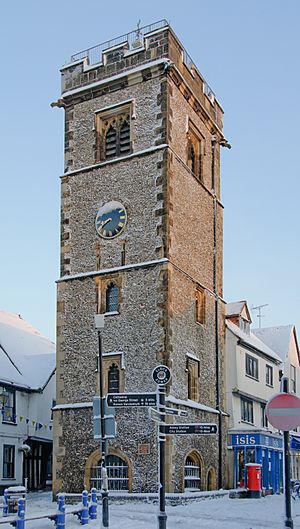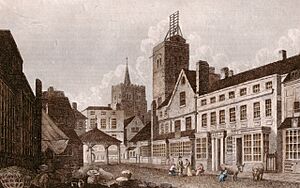Clock Tower, St Albans facts for kids
Quick facts for kids Clock Tower, St Albans |
|
|---|---|

The Clock Tower in St Albans
|
|
| Type | Clock tower |
| Location | St Albans, Hertfordshire, England, UK |
| Nearest city | St Albans |
| Height | 19.6 metres (64 ft) |
| Built | c. 1405 |
| Original use | Bell tower |
| Restored | 1866 |
| Restored by | George Gilbert Scott |
| Current use | Clock tower |
| Architect | Thomas Wolvey |
| Architectural style(s) | Medieval |
| Owner | St Albans City & District Council |
| Website | Clock Tower—St Albans Museums |
|
Listed Building – Grade I
|
|
| Official name: Clock Tower | |
| Designated | 1950-05-07 |
| Reference no. | 1103127 |
| Lua error in Module:Location_map at line 420: attempt to index field 'wikibase' (a nil value). | |
The St Albans Clock Tower is a very old building in St Albans, England. It was built between 1403 and 1412. Many people believe it was finished in 1405. This tower is thought to be the only medieval (Middle Ages) town bell tower left in England.
People think the tower was built as a way for the townspeople to show they didn't like the power of the local abbey. The abbey used to control time-keeping in the town. The Clock Tower helped the town have its own time.
Contents
What the Clock Tower Looks Like
The Clock Tower stands about 19.6 metres (64 ft) tall. It has five levels, including the roof. Each level gets a little bit narrower as it goes up. The outside of the tower is made of flint stone. It has special carved stones on its corners.
The top of the tower has a stone wall with battlements, like a castle. You can also see gargoyles on each corner. The ground floor has three wide windows. The upper floors have different types of windows. You can reach the top floor by climbing a spiral staircase with 93 steps.
The Clock Tower's Story
The Clock Tower was built between 1403 and 1412. It was likely finished in 1405. It stands near where an Eleanor cross used to be. King Edward I built 12 Eleanor crosses across England. He built them between 1291 and 1294. They were a memorial to his wife, Eleanor of Castile. Each cross marked a place where her funeral procession stopped for the night.
The cross in St Albans was built in 1291. Parts of it were destroyed during the English Civil War. The rest was taken down in 1701–1702. Later, other structures were built and removed in its place.

Thomas Wolvey, a former Royal Mason, designed and built the tower. Many believe it was a protest against the power of St Albans Abbey. Local merchants wanted the tower. This meant the abbey would no longer control their working hours. The Clock Tower is on higher ground than the abbey. It also faces the abbey directly.
We don't know if the tower had a clock face from the start. But we know it had one by 1485.
During the Napoleonic Wars, the Clock Tower was very useful. Its height made it perfect for a semaphore station. A semaphore station used signals to send messages. This station was part of a line from London to Great Yarmouth. Messages could travel along this line in just 5 minutes! A small wooden hut was built on the roof for this purpose. The hut was removed in 1852.
By 1858, the tower was in bad shape. Some parts were even destroyed. In 1863, people suggested tearing it down. But a famous architect, Sir Gilbert Scott, looked at it. He said it could be fixed for about £700. The repairs cost £1000 and were finished in 1866. Most of the outside stone was replaced. New features like gargoyles and windows were added.
Historically, the ground floor was a shop. The first floor was for the shopkeeper to live. The second floor was for the clock keeper. The third floor held the clock. The bells were on the fourth floor.
Today, the St Albans District Council owns and runs the Clock Tower.
Bells and Clock Details
The Clock Tower has two bells. One is called Gabriel, and the other is the Market bell. The Market bell was made around 1729. It was used to announce the opening of St Albans Market. It rang at 10:00 AM. Only special traders could sell before the bell rang. This bell was used until 1835.
Gabriel is the bigger bell. Its name comes from a Latin message on it. It means "I am Heaven sent, in Gabriel's name." We don't know exactly when it was made. But experts think it was cast around 1335. Gabriel weighs about one ton. It would have rung early in the morning and again in the evening. It could also ring for emergencies, like a fire. It even rang during the First Battle of St Albans.
It's not known when the clock was first put in the tower. Clocks were very rare back then. The tower was called the "Clokkehouse" in 1412. This might mean it had a clock, or just that the bells rang on the hour. We know for sure a clock existed in 1485. A tenant was even paid to wind and care for it.
The clock you see today was installed in 1866. Its mechanism was designed by Lord Grimthorpe. He also designed the famous clock mechanism for Big Ben in London! The 1866 clock cost £200. It needed to be wound "every fourth day."
The clock mechanism will be repaired in 2021. This work is being done by Smiths of Derby. Historic England is helping to pay for it.
Visiting the Clock Tower
The Clock Tower is open on weekends and bank holidays. This is usually from Good Friday until the end of September. It also opens for special events. For example, it opens during the Heritage Open Days scheme. It might also open when the St Albans Christmas Lights are turned on.
Volunteers from local societies help open the tower.


